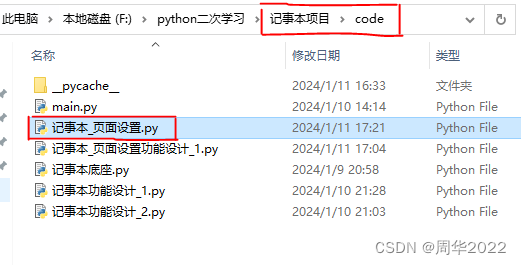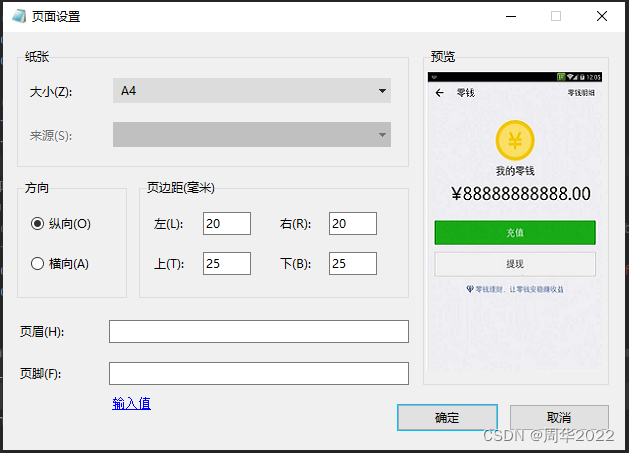【Python】使用tkinter设计开发Windows桌面程序记事本(3)
发布时间:2024年01月11日
上一篇:【Python】使用tkinter设计开发Windows桌面程序记事本(2)-CSDN博客
下一篇:
作者发炎
本文章与"记事本项目"的第一篇文章类似。这里是重新创建新的"页面设置"子窗口,进行开发设计。
那为什么与上一篇文章没有衔接呢?是因为这个"页面设置"是一个独立的子窗口,并且受主窗口调度。如果代码模块混为设计开发,就会降低可读性,并且不利于代码模块维护与迭代升级。
有疑问或建议,欢迎在评论区戳我哟!
设计步骤
在"记事本项目" --> "code"目录下新建项目代码模块文件"记事本_页面设置.py"设计开发,如下图:

运行结果

代码示例:记事本_页面设置.py
"""
记事本(打印)页面设置
"""
# 通配符 "*"
__all__ = ['PageSetup_base']
__all__.extend(['PAPER_VAR', 'PAPER_ORIENT', 'LEFT_VAR', 'RIGHT_VAR', 'TOP_VAR', 'BOTTOM_VAR', 'HEADER_VAR', 'FOOTER_VAR'])
# 导入内置模块
import tkinter as tk
from tkinter import ttk
# 全局变量
# 永久保存变量
PAPER_VAR = 'A4'
PAPER_ORIENT = 1
LEFT_VAR = 20
RIGHT_VAR = 20
TOP_VAR = 25
BOTTOM_VAR = 25
HEADER_VAR = ''
FOOTER_VAR = ''
class PageSetup_base(tk.Toplevel):
""" 继承tk.Toplevel, 设计记事本(打印)页面设置 """
def __init__(self):
""" 重写父类的构造方法 """
# 调用父类的构造方法
super().__init__()
""" 开始对记事本(打印)页面设置进行设计 """
self.title('页面设置') # 窗口标题
self.geometry(f'622x418+{self.winfo_screenwidth() // 4 + 60}+{self.winfo_screenheight() // 8 + 52}')
self.focus() # 设置窗口焦点
self.resizable(0, 0) # 禁止窗口的放大
self.grab_set() # 锁定父窗口
# 修改窗口标题的图片
self.PageSetup_photo = tk.PhotoImage(file='.\\..\\photo\\记事本.png')
self.iconphoto(True, self.PageSetup_photo)
""" 窗口布局 """
# (打印)纸张选择
self.paperFrame = ttk.LabelFrame(self, text='纸张', padding=(191, 38))
self.paperFrame.place(x=14, y=16)
tk.Label(self.paperFrame).pack()
# 大小
self.size = tk.Label(self, text='大小(Z):')
self.size.place(x=24, y=48)
# 来源
self.source = tk.Label(self, text='来源(S):', state='disable')
self.source.place(x=24, y=92)
""" 纸张大小下拉菜单 """
# 修改 OptionMenu 的样式
self.style = ttk.Style()
self.style.configure("my.TMenubutton", background='#DCDCDC', width=35)
# 纸张大小下拉菜单
self.paperVar = tk.StringVar(value=PAPER_VAR)
self.paperSelection = [self.paperVar.get(), f'A3{" " * 55}', 'A4', 'A5', 'B4 (JIS)', 'B5 (JIS)', 'Executive',
'Statement', 'Tabloid', '法律专用纸', '信纸']
self.paperMenu = ttk.OptionMenu(self, self.paperVar, *self.paperSelection, style="my.TMenubutton")
self.paperMenu.place(x=110, y=46)
""" 纸张来源下拉菜单 """
# 修改 OptionMenu 的样式
self.style.configure("my2.TMenubutton", background='#C0C0C0', width=35)
# 纸张大小下拉菜单
self.sourceVar = tk.StringVar()
self.sourceOption = [None, f'选项1{" " * 55}', '选项2', '选项3']
self.sourceMenu = ttk.OptionMenu(self, self.sourceVar, *self.sourceOption, style="my2.TMenubutton")
self.sourceMenu.config(state="disabled")
self.sourceMenu.place(x=110, y=90)
# (打印纸张)方向选择
self.orientFrame = ttk.LabelFrame(self, text='方向', padding=(50, 38))
self.orientFrame.place(x=14, y=147)
tk.Label(self.orientFrame).pack()
self.orientVar = tk.IntVar(value=PAPER_ORIENT)
# (打印纸张)纵向
self.lengthways = ttk.Radiobutton(self, text='纵向(O)', variable=self.orientVar, value=1)
self.lengthways.place(x=26, y=180)
# (打印纸张)横向
self.crosswise = ttk.Radiobutton(self, text='横向(A)', variable=self.orientVar, value=2)
self.crosswise.place(x=26, y=220)
# (打印纸张)页边距(毫米)
self.marginFrame = ttk.LabelFrame(self, text='页边距(毫米)', padding=(130, 38))
self.marginFrame.place(x=136, y=147)
tk.Label(self.marginFrame).pack()
# 文字标签
tk.Label(self, text='左(L):').place(x=148, y=180)
tk.Label(self, text='右(R):').place(x=274, y=180)
tk.Label(self, text='上(T):').place(x=148, y=220)
tk.Label(self, text='下(B):').place(x=274, y=220)
# 输入框
self.leftVar = tk.IntVar(value=LEFT_VAR)
self.rightVar = tk.IntVar(value=RIGHT_VAR)
self.topVar = tk.IntVar(value=TOP_VAR)
self.bottomVar = tk.IntVar(value=BOTTOM_VAR)
self.leftEntry = ttk.Entry(self, width=6, textvariable=self.leftVar)
self.leftEntry.place(x=200, y=180)
self.rightEntry = ttk.Entry(self, width=6, textvariable=self.rightVar)
self.rightEntry.place(x=326, y=180)
self.topEntry = ttk.Entry(self, width=6, textvariable=self.topVar)
self.topEntry.place(x=200, y=220)
self.bottomEntry = ttk.Entry(self, width=6, textvariable=self.bottomVar)
self.bottomEntry.place(x=326, y=220)
# (打印纸张)预览
self.previewFrame = ttk.LabelFrame(self, text='预览', padding=(88, 147))
self.previewFrame.place(x=420, y=16)
tk.Label(self.previewFrame).pack()
self.preview_photo = tk.PhotoImage(file='.\\..\\photo\\微信余额.png')
tk.Label(self, image=self.preview_photo).place(x=421, y=37)
# 页眉、页脚变量
self.headerVar = tk.StringVar(value=HEADER_VAR)
self.footerVar = tk.StringVar(value=FOOTER_VAR)
# 页眉
tk.Label(self, text='页眉(H):').place(x=14, y=288)
self.headerEntry = ttk.Entry(self, width=42, textvariable=self.headerVar)
self.headerEntry.place(x=106, y=288)
# 页脚
tk.Label(self, text='页脚(F):').place(x=14, y=330)
self.footerEntry = ttk.Entry(self, width=42, textvariable=self.footerVar)
self.footerEntry.place(x=106, y=330)
# 页眉页脚输入值网页详情介绍
# 修改 Button 的样式
# style.configure("my.TButton", width=6, font=("Arial", 10, 'underline'), foreground="blue")
# ttk.Button(set, text='输入值', style='my.TButton').place(x=106, y=360)
self.headerFooterWeb = tk.Label(self, text='输入值', relief='flat', foreground="blue", font=("Arial", 10, 'underline'))
self.headerFooterWeb.place(x=106, y=360)
# 确定
# 修改 Button 的样式
self.style.map("my.TButton", background=[('!active', '!disabled', '#00BFFF')])
self.confirm = ttk.Button(self, text='确定', width=13, style='my.TButton')
self.confirm.place(x=394, y=372)
# 取消
self.cancel = ttk.Button(self, text='取消', width=13)
self.cancel.place(x=506, y=372)
# 代码测试
if __name__ == '__main__':
ui = PageSetup_base() # 实例化页面设置
ui.mainloop() # 循环窗口运行
else:
print(f'导入【{__name__}】')
作者:周华
创作日期:2024/1/11
文章来源:https://blog.csdn.net/zhouhua2022/article/details/135534486
本文来自互联网用户投稿,该文观点仅代表作者本人,不代表本站立场。本站仅提供信息存储空间服务,不拥有所有权,不承担相关法律责任。 如若内容造成侵权/违法违规/事实不符,请联系我的编程经验分享网邮箱:chenni525@qq.com进行投诉反馈,一经查实,立即删除!
本文来自互联网用户投稿,该文观点仅代表作者本人,不代表本站立场。本站仅提供信息存储空间服务,不拥有所有权,不承担相关法律责任。 如若内容造成侵权/违法违规/事实不符,请联系我的编程经验分享网邮箱:chenni525@qq.com进行投诉反馈,一经查实,立即删除!
最新文章
- Python教程
- 深入理解 MySQL 中的 HAVING 关键字和聚合函数
- Qt之QChar编码(1)
- MyBatis入门基础篇
- 用Python脚本实现FFmpeg批量转换
- Nature | 化学领域的ChatGPT:人工智能与机器人联合打造新材料
- 项目管理常用的ChatGPT通用提示词模板
- 多线程辅助类,可在线程忙时访问其属性和方法
- Java 应用部署包优化经验分享
- 互联网广告行业发展历程
- 《编程之光:解密ECMAScript与JavaScript的微妙关系》
- JS 实现带手柄自由调整页面大小的功能
- 网络基础操作练习
- 初学者必备!在线Axure中文版,原型设计零难度!
- 【高等数学之定积分】